Bettering biosecurity: Lessons from avian influenza
How can you best protect your swine operation, should African swine fever or classical swine fever show up on U.S. soil?
January 23, 2024

By Craig Rowles, Versova Management Company
I graduated from veterinary school in 1982 in the midst of the U.S. farm crisis, when we began to see the consolidation of family farms that would lead to large indoor swine houses. In the mid-1990s, I transitioned from full-time veterinary work into co-owning and managing Elite Pork Partnership with partners who were primarily egg producers looking to diversify their income with pigs. In 2014, we sold that business, and I moved into leading Versova’s cage-free egg operations in Iowa, Ohio, Washington and Oregon.
Much as the beginning of my veterinary career was marked by crisis in agriculture, so was my start in poultry — in December 2014, highly pathogenic avian influenza was detected in the U.S. for the first time in a decade, hitting Iowa particularly hard and resulting in the death or depopulation of more than 50 million chickens and turkeys nationwide over several months. This was the largest HPAI outbreak recorded in the U.S., until 2022.
My most immediate experience with a transboundary disease (also known as FAD, or foreign-animal disease) at that time was the porcine epidemic diarrhea virus, first detected in the U.S. in 2013.
Unlike my entry into pork production nearly 30 years ago, when I was following industry trends, at Versova my job is to lead change and improvement for our company. Part of that is to draw from my experiences so we are prepared for the next avian FAD outbreak to happen — and hope it never comes to pass.
Simple measures matter
The FADs swine producers probably most fear are African swine fever and classical swine fever. While the closest ASF has come to the U.S. is the islands of Haiti and the Dominican Republic, CSF was eradicated from our herds in 1978. Both are extremely contagious and result in high swine mortality, though neither is harmful to human health. They have proven devastating to the livelihoods of producers overseas— so how can you best protect your swine operation, should either show up on U.S. soil?
Installation of and adherence to strict biosecurity measures on your farm is the single most proactive measure you can take to prevent any FAD from infecting your animals even if it should reach the U.S.; the same can be said about most domestic and enteric pathogens.
Epidemiology done at the time of the 2014-15 HPAI outbreak demonstrated just how widely the virus was being transmitted farm-to-farm laterally because of poor biosecurity. It was clear, based on the evidence demonstrated through virus genotyping, that we were dragging the same virus through poultry trucks, contract employees and lack of biosecurity practices — the primary vector for spreading it was to step into wild-bird fecal matter outside, then track it into our birds’ area. In heart-to-heart discussions among ourselves when it was over, we usually started with, “What are we going to do differently next time?”
One of the first changes we made was in facility infrastructure, such as biosecure buildings that were not only safe but a pleasant environment for employees that wasn’t only utilitarian. Since it’s not feasible to rebuild those old finishing barns, for example, you could add a Danish entry to the existing structure. Developed in Denmark to cut down on fecal-to-oral pathogen transmission in pork production, this is a single space with separation between the zone for “dirty” clothes and boots from outside and “clean” attire to go into the barn.
We also instituted features that would entice everyone to follow biosecurity measures and not “cheat” by taking old shortcuts. When you have many employees going through the same shower in a day, details such as ensuring the last person has access to the same nice hot water and clean dress-out clothes as the first person did make a difference.
Look for the easiest things to begin with, or the “low-hanging fruit.” These may be everyday measures; for instance, if a feed bin gets hung up, workers used to just walk out and bang on it, then go back inside. Procedures to prevent potential pathogens from entering the birds’ area are inconvenient — and the distance out to the bin isn’t far, so it’s easy to think, “Well, I’ll just pop out — no need to change my boots.” To remedy this, we installed vibrators in all the bins with the buttons inside the barn, so if a bin gets hung up, the employee can un-jar it without decontamination and exiting.
Another disease vector is transportation, since running livestock and even feed trucks back and forth from the farm is a great way to spread germs. Simple changes could include separate entrances for delivery vehicles that do not need to be near the barn — such as if you have a feed mill on-site. If you can’t afford your own on-farm truck wash, consider partnering with other local producers to pay for a wash near the meatpacker so departing empty trucks can be cleaned of the bulk of potential contamination.
Creating a biosecure operation for swine can be as simple as thinking through normal everyday processes for workers and trying to mitigate common vectors of transmission. Following biosecurity measures are difficult, expensive, inconvenient … and absolutely necessary to have any success in keeping out illnesses that could decimate your herd.
Carthage Veterinary Service relies on science and experience to provide unique and practical solutions to achieve the best outcomes for producers and their animals. Our teams work with producers and our production teams daily, and have a deep understanding of the challenges and intricacies of swine nutrition.
You May Also Like



